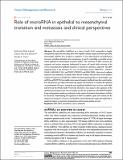Por favor, use este identificador para citar o enlazar a este item:
http://hdl.handle.net/10261/124563COMPARTIR / EXPORTAR:
 SHARE SHARE
 CORE
BASE CORE
BASE
|
|
| Visualizar otros formatos: MARC | Dublin Core | RDF | ORE | MODS | METS | DIDL | DATACITE | |

| Campo DC | Valor | Lengua/Idioma |
|---|---|---|
| dc.contributor.author | Díaz-López, Antonio | - |
| dc.contributor.author | Moreno-Bueno, Gema | - |
| dc.contributor.author | Cano, Amparo | - |
| dc.date.accessioned | 2015-11-05T13:11:10Z | - |
| dc.date.available | 2015-11-05T13:11:10Z | - |
| dc.date.issued | 2014 | - |
| dc.identifier | doi: 10.2147/CMAR.S38156 | - |
| dc.identifier | issn: 1179-1322 | - |
| dc.identifier.citation | Cancer Management and Research 6: 205-216 (2014) | - |
| dc.identifier.uri | http://hdl.handle.net/10261/124563 | - |
| dc.description.abstract | The microRNAs (miRNAs) are a class of small, 20-22 nucleotides in length, endogenously expressed noncoding RNAs that regulate multiple targets posttranscriptionally. Interestingly, miRNAs have emerged as regulators of most physiological and pathological processes, including metastatic tumor progression, in part by controlling a reversible process called epithelial-to-mesenchymal transition (EMT). The activation of EMT increases the migratory and invasive properties fundamental for tumor cell spread while activation of the reverse mesenchymal-to-epithelial transition is required for metastasis outgrowth. The EMT triggering leads to the activation of a core of transcription factors (EMT-TFs) - SNAIL1/ SNAIL2, bHLH (E47, E2-2, and TWIST1/TWIST2), and ZEB1/ZEB2 - that act as E-cadherin repressors and, ultimately, coordinate EMT. Recent evidence indicates that several miRNAs regulate the expression of EMT-TFs or EMT-activating signaling pathways. Interestingly, some miRNAs and EMT-TFs form tightly interconnected negative feedback loops that control epithelial cell plasticity, providing self-reinforcing signals and robustness to maintain the epithelial or mesenchymal cell status. Among the most significant feedback loops, we focus on the ZEB/ miR-200 and the SNAIL1/miR-34 networks that hold a clear impact in the regulation of the epithelial-mesenchymal state. Recent insights into the p53 modulation of the EMT-TF/miRNA loops and epigenetic regulatory mechanisms in the context of metastasis dissemination will also be discussed. Understanding the regulation of EMT by miRNAs opens new avenues for the diagnosis and prognosis of tumors and identifies potential therapeutic targets that might help to negatively impact on metastasis dissemination and increasing patient survival. | - |
| dc.description.sponsorship | AC is funded by grants of the Spanish Ministry of Economy and Competitiveness, formerly Innovation and Sciences, (SAF2010-21143; Consolider-Ingenio CSD2007-00017) and Association for International Cancer Research (grant 12-1057). GMB is funded by SAF2010-20175, AECC-2011 and Instituto de Salud Carlos III (ISCIII) PI13/00132. GMB and AC are funded by the Community of Madrid (S2010/BMD-2303) and the Instituto de Salud Carlos III (RETICRD12/0036/0007). ADL is a postdoctoral researcher funded by the Sara Borrell program (ISCIII). | - |
| dc.publisher | Dove Press | - |
| dc.relation | S2010/BMD-2303/RECARE | - |
| dc.rights | openAccess | - |
| dc.title | Role of microRNA in epithelial to mesenchymal transition and metastasis and clinical perspectives | - |
| dc.type | artículo | - |
| dc.identifier.doi | 10.2147/CMAR.S38156 | - |
| dc.relation.publisherversion | http://dx.doi.org/10.2147/CMAR.S38156 | - |
| dc.date.updated | 2015-11-05T13:11:11Z | - |
| dc.description.version | Peer Reviewed | - |
| dc.language.rfc3066 | eng | - |
| dc.rights.license | https://creativecommons.org/licenses/by-nc/3.0/us/ | - |
| dc.contributor.funder | Comunidad de Madrid | - |
| dc.contributor.funder | Association for International Cancer Research | - |
| dc.contributor.funder | Asociación Española Contra el Cáncer | - |
| dc.contributor.funder | Instituto de Salud Carlos III | - |
| dc.contributor.funder | Ministerio de Economía y Competitividad (España) | - |
| dc.relation.csic | Sí | - |
| dc.identifier.funder | http://dx.doi.org/10.13039/100004435 | es_ES |
| dc.identifier.funder | http://dx.doi.org/10.13039/501100004587 | es_ES |
| dc.identifier.funder | http://dx.doi.org/10.13039/501100003329 | es_ES |
| dc.identifier.funder | http://dx.doi.org/10.13039/100012818 | es_ES |
| dc.identifier.pmid | 24812525 | - |
| dc.type.coar | http://purl.org/coar/resource_type/c_6501 | es_ES |
| item.openairecristype | http://purl.org/coar/resource_type/c_18cf | - |
| item.fulltext | With Fulltext | - |
| item.cerifentitytype | Publications | - |
| item.openairetype | artículo | - |
| item.grantfulltext | open | - |
| Aparece en las colecciones: | (IIBM) Artículos | |
Ficheros en este ítem:
| Fichero | Descripción | Tamaño | Formato | |
|---|---|---|---|---|
| Role of microRNA.pdf | 313,95 kB | Adobe PDF |  Visualizar/Abrir |
CORE Recommender
PubMed Central
Citations
89
checked on 15-abr-2024
SCOPUSTM
Citations
159
checked on 16-abr-2024
WEB OF SCIENCETM
Citations
155
checked on 26-feb-2024
Page view(s)
312
checked on 19-abr-2024
Download(s)
363
checked on 19-abr-2024

